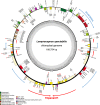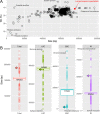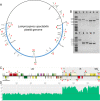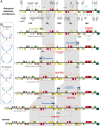Reconfiguration of the plastid genome in Lamprocapnos spectabilis: IR boundary shifting, inversion, and intraspecific variation
- PMID: 30206286
- PMCID: PMC6134119
- DOI: 10.1038/s41598-018-31938-w
Reconfiguration of the plastid genome in Lamprocapnos spectabilis: IR boundary shifting, inversion, and intraspecific variation
Abstract
We generated a complete plastid genome (plastome) sequence for Lamprocapnos spectabilis, providing the first complete plastome from the subfamily Fumarioideae (Papaveraceae). The Lamprocapnos plastome shows large differences in size, structure, gene content, and substitution rates compared with two sequenced Papaveraceae plastomes. We propose a model that explains the major rearrangements observed, involving at least six inverted repeat (IR) boundary shifts and five inversions, generating a number of gene duplications and relocations, as well as a two-fold expansion of the IR and miniaturized small single-copy region. A reduction in the substitution rates for genes transferred from the single-copy regions to the IR was observed. Accelerated substitution rates of plastid accD and clpP were detected in the Lamprocapnos plastome. The accelerated substitution rate for the accD gene was correlated with a large insertion of amino acid repeat (AAR) motifs in the middle region, but the forces driving the higher substitution rate of the clpP gene are unclear. We found a variable number of AARs in Lamprocapnos accD and ycf1 genes within individuals, and the repeats were associated with coiled-coil regions. In addition, comparative analysis of three Papaveraceae plastomes revealed loss of rps15 in Papaver, and functional replacement to the nucleus was identified.
Conflict of interest statement
The authors declare no competing interests.
Figures







Similar articles
-
Extreme Reconfiguration of Plastid Genomes in Papaveraceae: Rearrangements, Gene Loss, Pseudogenization, IR Expansion, and Repeats.Int J Mol Sci. 2024 Feb 14;25(4):2278. doi: 10.3390/ijms25042278. Int J Mol Sci. 2024. PMID: 38396955 Free PMC article.
-
Gene loss, genome rearrangement, and accelerated substitution rates in plastid genome of Hypericum ascyron (Hypericaceae).BMC Plant Biol. 2022 Mar 23;22(1):135. doi: 10.1186/s12870-022-03515-x. BMC Plant Biol. 2022. PMID: 35321651 Free PMC article.
-
Lineage-Specific Variation in IR Boundary Shift Events, Inversions, and Substitution Rates among Caprifoliaceae s.l. (Dipsacales) Plastomes.Int J Mol Sci. 2021 Sep 28;22(19):10485. doi: 10.3390/ijms221910485. Int J Mol Sci. 2021. PMID: 34638831 Free PMC article.
-
Extensive genomic rearrangements mediated by repetitive sequences in plastomes of Medicago and its relatives.BMC Plant Biol. 2021 Sep 14;21(1):421. doi: 10.1186/s12870-021-03202-3. BMC Plant Biol. 2021. PMID: 34521343 Free PMC article.
-
Highly accelerated rates of genomic rearrangements and nucleotide substitutions in plastid genomes of Passiflora subgenus Decaloba.Mol Phylogenet Evol. 2019 Sep;138:53-64. doi: 10.1016/j.ympev.2019.05.030. Epub 2019 May 23. Mol Phylogenet Evol. 2019. PMID: 31129347
Cited by
-
Phylogenomics and plastome evolution of Lithospermeae (Boraginaceae).BMC Plant Biol. 2024 Oct 14;24(1):957. doi: 10.1186/s12870-024-05665-6. BMC Plant Biol. 2024. PMID: 39396939 Free PMC article.
-
Comparative Chloroplast Genomics at Low Taxonomic Levels: A Case Study Using Amphilophium (Bignonieae, Bignoniaceae).Front Plant Sci. 2019 Jun 19;10:796. doi: 10.3389/fpls.2019.00796. eCollection 2019. Front Plant Sci. 2019. PMID: 31275342 Free PMC article.
-
Phylogenomics and plastomics offer new evolutionary perspectives on Kalanchoideae (Crassulaceae).Ann Bot. 2024 Apr 23;133(4):585-604. doi: 10.1093/aob/mcae017. Ann Bot. 2024. PMID: 38359907 Free PMC article.
-
Comparative analysis of the complete chloroplast genome of Papaveraceae to identify rearrangements within the Corydalis chloroplast genome.PLoS One. 2023 Sep 21;18(9):e0289625. doi: 10.1371/journal.pone.0289625. eCollection 2023. PLoS One. 2023. PMID: 37733832 Free PMC article.
-
Cold Resistance of Euonymus japonicus Beihaidao Leaves and Its Chloroplast Genome Structure and Comparison with Celastraceae Species.Plants (Basel). 2022 Sep 20;11(19):2449. doi: 10.3390/plants11192449. Plants (Basel). 2022. PMID: 36235317 Free PMC article.
References
-
- Ruhlman, T. A. & Jansen, R. K. In Chloroplast Biotechnology: Methods and Protocols (ed. Pal Maliga) 3–38 (Humana Press, 2014).
Publication types
MeSH terms
Grants and funding
LinkOut - more resources
Full Text Sources
Other Literature Sources
Miscellaneous

